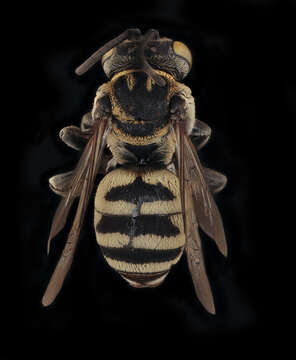Triepeolus heterurus, f, back, Yolo Co., CA_2019-03-21-21.09.05 ZS PMax UDR

Description:
Triepeolus heterurus, one of many kinds of Triepeolus in the new world. For some reason, while there are a robust 140+ species in the New World there appears to be only 2 in the unnew world. One in Asia. One Europe. This may be reasonable given that the bulk of Triepeolus are cleptoparasites of long-horned bees in the genus Melissodes (there are many species of those too). And Melissodes do not occur in the unnew world. On the other hand Triepeolus also home invade several other genera of bees, including species outside of the Family Apidae, showing that they are flexible. So, in sum, I posit the hypothesis that the food of Asia, Europe, and Africa (I am ignoring Australia on purpose) does not suit Triepeolus and that is why they are scarce there (note, this in no way demonstrates some sort of "fallen" state of the unnew world). There are possibly other alternative hypotheses and would encourage more hypothisetical expositarianism. "This bee was collected in the California Central Valley in Yolo County for research on small-scale restoration in agricultural areas. Claire Kremen's 10-year study of hedgerows shows the benefits of planting native shrubs and forbs in agricultural areas for native bees. To learn more about the Kremen Lab and hedgerows, see nature.berkeley.edu/kremenlab/" Photo by Brooke Goggins. ~~~~~~~~~~{{{{{{0}}}}}}~~~~~~~~~~ All photographs are public domain, feel free to download and use as you wish. Photography Information: Canon Mark II 5D, Zerene Stacker, Stackshot Sled, 65mm Canon MP-E 1-5X macro lens, Twin Macro Flash in Styrofoam Cooler, F5.0, ISO 100, Shutter Speed 200 We Are Made One with What We Touch and See We are resolved into the supreme air, We are made one with what we touch and see, With our heart's blood each crimson sun is fair, With our young lives each spring impassioned tree Flames into green, the wildest beasts that range The moor our kinsmen are, all life is one, and all is change. - Oscar Wilde You can also follow us on Instagram - account = USGSBIML Want some Useful Links to the Techniques We Use? Well now here you go Citizen: Best over all technical resource for photo stacking: www.extreme-macro.co.uk/ Art Photo Book: Bees: An Up-Close Look at Pollinators Around the World: www.amazon.com/Bees-Up-Close-Pollinators-Around-World/dp/... Free Field Guide to Bee Genera of Maryland: bio2.elmira.edu/fieldbio/beesofmarylandbookversion1.pdf Basic USGSBIML set up: www.youtube.com/watch?v=S-_yvIsucOY USGSBIML Photoshopping Technique: Note that we now have added using the burn tool at 50% opacity set to shadows to clean up the halos that bleed into the black background from "hot" color sections of the picture. www.youtube.com/watch?v=Bdmx_8zqvN4 Bees of Maryland Organized by Taxa with information on each Genus www.flickr.com/photos/usgsbiml/collections PDF of Basic USGSBIML Photography Set Up: Google Hangout Demonstration of Techniques: plus.google.com/events/c5569losvskrv2nu606ltof8odo or www.youtube.com/watch?v=4c15neFttoU Excellent Technical Form on Stacking: www.photomacrography.net/ Contact information: Sam Droege sdroege@usgs.gov 301 497 5840
Included On The Following Pages:
- Life (creatures)
- Cellular (cellular organisms)
- Eukaryota (eukaryotes)
- Opisthokonta (opisthokonts)
- Metazoa (Animal)
- Bilateria
- Protostomia (protostomes)
- Ecdysozoa (ecdysozoans)
- Arthropoda (arthropods)
- Pancrustacea
- Hexapoda (hexapods)
- Insecta (insects)
- Pterygota (winged insects)
- Neoptera (neopteran)
- Endopterygota (endopterygotes)
- Hymenoptera (wasps, bees, and ants)
- Apocrita (wasp)
- Aculeata
- Apoidea (bees & apoid Wasps)
- Anthophila (bee)
- Apidae (honeybees, bumblebees, and relatives)
- Nomadinae (cuckoo bee)
- Epeolini
- Triepeolus
- Triepeolus utahensis
This image is not featured in any collections.
Source Information
- license
- cc-publicdomain
- copyright
- USGS Bee Inventory and Monitoring Lab
- photographer
- USGS Bee Inventory and Monitoring Lab
- original
- original media file
- visit source
- partner site
- USGS Bee Inventory and Monitoring Lab
- ID


